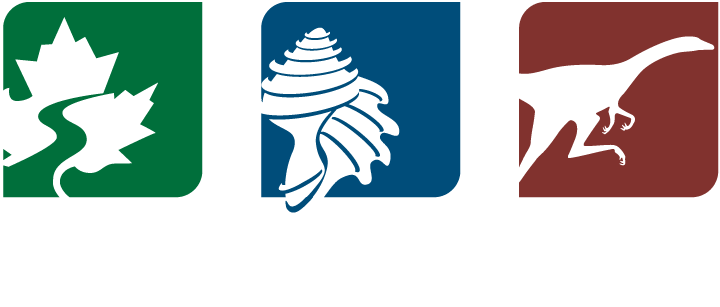Harmful algal bloom in West Basin of Lake Erie: September 20, 2017. Photo by Aerial Associates Photography, Inc. by Zachary Haslick (flickr, Creative Commons Attribution-ShareAlike 2.0 Generic license).
HABs in Lakes
HABs in lakes
HABs occur in many lakes throughout the world, especially lakes with warm water and lakes that receive influxes of nutrients from pollution. Warm water may occur seasonally or year-round, depending on the location of the lake. Sources of nutrient-containing pollutants that flow into lakes include sewage, animal waste, fertilizers, runoff from urban and residential areas, soil erosion, industrial waste, and even air pollution.
An image showing the sources of nutrients and other factors involved in the development of cyanobacterial HABs in lakes. Source: Graham et al. (2017) USGS Open File Report 2016-1174.
Cyanobacteria in lake HABs
Many HABs in freshwater lakes are caused by cyanobacteria (blue-green algae). These tiny organisms may exist as single cells, chains of cells that form thread-like filaments, or colonies of cells. Individual cyanobacterial cells, filaments, or small colonies cannot be seen with the naked eye. When many of these bacteria form a bloom, however, they can be so densely concentrated that they change the color of the water.
Some cyanobacteria that form HABs can produce toxins, although they do not always produce toxins. Three common types of toxin-producing cyanobacteria that often form HABs in freshwater lakes are Dolichospermum (formerly called Anabaena), Microcystis, and Planktothrix. Planktothrix can cause pink or red blooms, whereas the other two types of cyanobacteria cause green or blue-green blooms.
Some HAB-forming cyanobacteria do not produce toxins, but may still make water unsightly, cause oxygen depletion, and have other harmful effects. From example, Limnoraphis, which does not produce toxins, is an important bloom-former in tropical lakes. This cyanobacterium may co-occur with toxin-producing species or may form blooms on its own. Blooms of Limnoraphis may be yellow-brown.
Cyanotoxins: effects and exposure
Cyanobacteria may produce different types of cyanotoxins, like anatoxin-a, cylindrospermopsin, microcystins, nodularins, and saxitoxin. Symptoms of cyanotoxin poisoning in animals and humans can include skin problems, headaches and abdominal pain, gastrointestinal symptoms like nausea and diarrhea, respiratory problems like coughing and pneumonia, neurological problems, and liver and kidney damage. Among cyanotoxins, microcystins are the most common found in fresh water. Microcystins are powerful liver toxins that accumulate in water and in fish populations.
Humans and animals may be exposed to cyanotoxins present in lakes in multiple ways. They may ingest cyanotoxins in their drinking water. Skin and eyes can be exposed to cyanotoxins that are present in water during work, bathing, or recreation. Cyanotoxins present in aerosols (water droplets suspended in air) can be inhaled, causing respiratory problems. Cyanotoxins may also be consumed in contaminated food, like fish taken from water where HABs were present.
HABs: A global phenomenon
Lake HABs do not always make the national or world news, and the presence and effects of HABs can be fleeting. However, more intensive land use by humans, which creates pollution and causes eutrophication, as well as climate change have contributed to the development of dramatic algal blooms in lakes. Below are examples of some lakes from around the world that have been impacted by HABs. The following two pages also provide information on HABs in lakes in two different parts of the world: the Finger Lakes of New York State, USA, and Lake Victoria of Kenya, Tanzania, and Uganda in eastern Africa.
Lake Erie (U.S.A. and Canada)
Lake Erie is one of the lakes that make up the five Great Lakes of the eastern United States and Canada. Lake Erie is bordered by the U.S. states of Michigan, Ohio, Pennsylvania, and New York, as well as the Canadian province of Ontario.
In recent years, Lake Erie has sometimes experienced dramatic summertime HABs. The reasons that HABs tend to form in Lake Erie include that the lake is relatively small (by volume) and shallow compared to the other Great Lakes. The Lake Erie basin is also highly developed, supporting multiple cities, industries, and intensive agriculture. These human activities add pollutants to the lake, like nitrogen and phosphorus, that feed algal growth.
HABs in Lake Erie disrupt activities like fishing and water sports. They can also affect the drinking water of municipalities that use the lake as a water source. In the summer of 2014, toxins affected the drinking water of Toledo, Ohio, and residents were warned not have contact with their tap water for about three days. Later that same summer, residents of Peelee Island, Canada, were told of avoid using their tap water for almost two weeks. NOAA (the U.S. National Oceanic and Atmospheric Administration) issues algal bloom forecasts for western Lake Erie, which fluctuate according to weather patterns, like temperature and precipitation. The U.S. and Canada are working to reduce nutrient inputs that feed algal blooms.
Lake Tai (China)
Lake Tai (also called Lake Taihu, among other names) is a lake located in Jiangsu and Zhejiang provinces in eastern China. It is China’s third largest freshwater lake and is very shallow, averaging a depth of about two meters. About 10 million people depend on the lake as a drinking water source, including many people in the city of Wuxi, which has a population of more than 7 million. About 40 million people live in the Lake Tai watershed. The lake itself supports fishing, shipping, and tourism.
The region around Lake Tai also supports agriculture and industry. The pollution from these activities, combined with the shallowness of the lake and climate conditions, has stimulated the growth of HABs in the lake since the 1990s. During 2007, a large Microcystis HAB formed, and many people (perhaps as many as 2 million) were left without drinking water for about a week due to the toxins produced by the algae. While efforts have been made to try to limit the amount of pollution reaching the lake, the lake remains polluted and continues to experience HABs.
Lake Villarrica (Chile)
Cyanobacterial blooms have been documented in lakes in northern Patagonia, Chile, including Lake Villarrica in the Araucanía region. These blooms started to appear in the lake around 2008 due to warm temperatures and nutrient-containing runoff from the surrounding region. Some of the main human activities increasing pollution in the lake are fish farming, agriculture, agroforestry, and urbanization. Microcystins have been detected in the lake water, posing risks for people who enjoy recreation in the lake when blooms are present.
Lake Windermere (U.K.)
Lake Windermere is the largest lake in England and is within Lakes District National Park in northwestern England. The lake was formed by glacial activity during the Pleistocene “Ice Age.” The region around the lake has been inhabited by humans for many centuries, and the lake has been experiencing eutrophication (increasing nutrient levels) from human activities since the 1800s.
While Lake Windermere is now cleaner than it was in the 1990s, pollution still contributes nitrogen and phosphorus. Combined with warming waters, these pollutants promote the growth of HABs. The major sources of pollution in Lake Windermere are thought be sewage released into the lake during storm events and pollution that comes from private septic systems. Agriculture also contributes some pollution. HABs in Lake Windermere have the potential to limit recreation in the lake during the summer season, which may have negative economic impacts by discouraging tourism.
Development of the Harmful Algal Blooms (HABs) section of the Cayuga Nature Center website was supported by a National Science Foundation grant to Kathryn Fiorella, Christopher Barrett, and Peter McIntyre of Cornell University (BCS 2009658). The views, findings, conclusions, or recommendations expressed in this website do not necessarily represent those of the National Science Foundation.





















